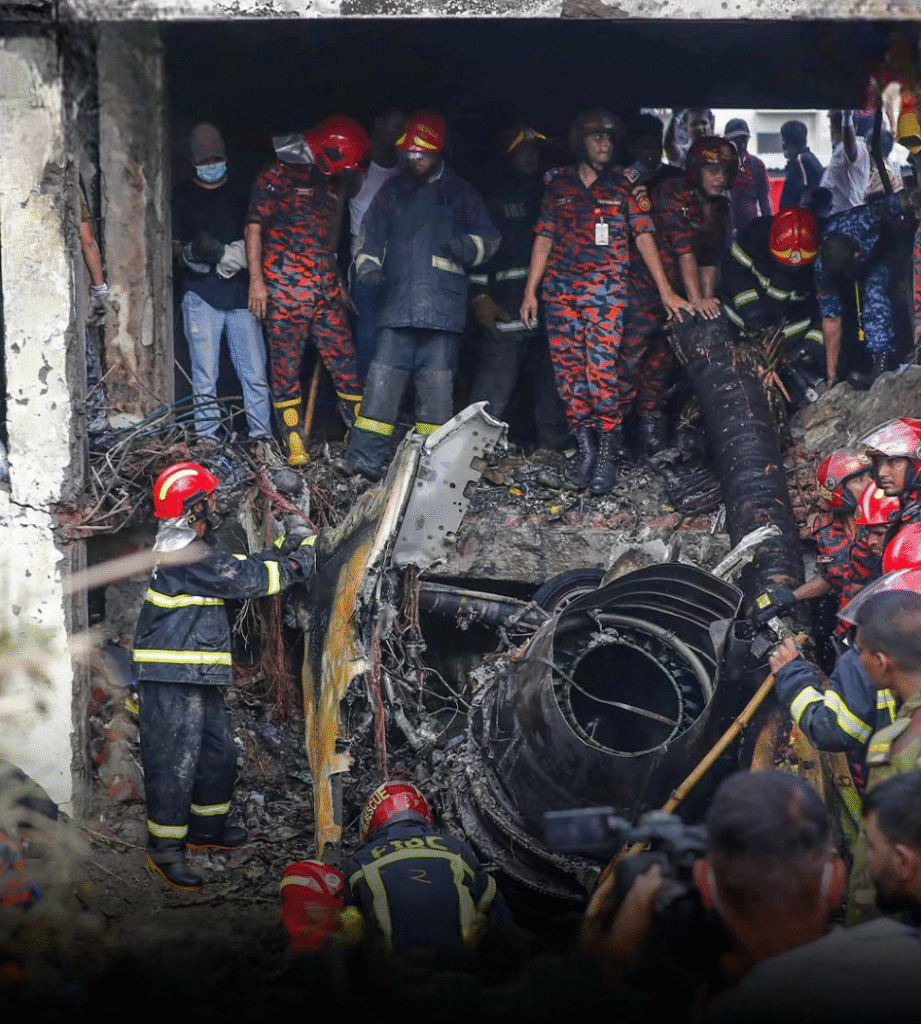On the afternoon of July 21, 2025, the bustling neighborhood of Uttara, Dhaka was torn apart by a catastrophe that will haunt Bangladesh for decades. The incident, now widely referred to as the Bangladesh Plane Crash, involved a Bangladesh Air Force F-7 BGI jet, conducting what was supposed to be a routine training flight. The jet crashed directly into the second floor of Milestone School & College—a campus full of young students.
While official sources have confirmed 25 deaths, eyewitnesses, scout members, and parents insist the real toll could be over 100 lives, most of them children. The gap between official reports and ground realities has sparked grief, anger, and urgent calls for justice.
Table of Contents
ToggleA Regular School Day Turned Nightmare
It was just past 1 PM when the Chinese-made F-7 BGI aircraft, which had taken off minutes earlier from AK Khandaker Air Base, suffered a technical failure. The pilot, Flight Lieutenant Towkir Islam Sagar, tried to divert the aircraft away from residential areas. He ejected moments before impact but later died of injuries in a Dhaka hospital.
At the time of the crash, school was fully in session. On the second floor, three full classroom units, each packed with 35 students, were conducting their lessons. Then, without warning, the fighter jet tore through the structure with a fiery explosion, sending flames, smoke, and debris across the area.
Witnesses described scenes of sheer horror—students screaming, teachers rushing to protect children, and then silence. The entire second floor was burned to ash, and many of the children were either burned alive or crushed under rubble.
At the time of the crash, all classes were in session. On the second floor, there were three classroom units, each packed with approximately 35 students, boys and girls alike. Without warning, the jet slammed into the upper level of the school, causing a massive explosion and immediate fire.
The classrooms were completely destroyed. Survivors recall burning debris, collapsing ceilings, and the smell of fuel in the air. Panic erupted. Children screamed for help. Some were buried under rubble, others burned beyond recognition.
Local scout groups, present in the area at the time, witnessed the incident and rushed to help rescue survivors. One scout leader said, “We saw bodies everywhere… It’s far more than what’s being reported on the news.”
A Face of the Tragedy: One Little Boy’s Silent Testimony
Among the countless heartbreaking stories emerging from the Milestone School jet crash, one stands out in quiet devastation—a brief video of a young boy, dazed and injured, sitting amid the chaos. His clothes are dusty, his eyes swollen with fear. He says nothing, but his expression tells the story of a thousand screams.
This six-second clip, shared widely on social media, has come to symbolize the vulnerability of the innocent victims caught in the crossfire of systemic negligence. The boy’s silent gaze is a question to the nation: “Why us?”
He is one of many children who survived—physically, at least. But the emotional scars etched in these moments will linger for a lifetime. His story is not unique, and that’s what makes it so powerful. It is the story of every child in that building. Every family still searching. Every mother waiting outside a hospital with a name and a prayer.
As Bangladesh mourns and demands answers, let us remember that behind every number in the official death toll, there is a child like him—a life interrupted, a future forever changed.
Eyewitnesses Speak: “It Was Hell on Earth”
One of the first groups to respond was the local scout troop, who happened to be nearby. According to a 17-year-old scout member, “We rushed toward the school after hearing the blast. It wasn’t just 20 people. I personally saw more than 40 lifeless bodies. We couldn’t even recognize some of them.”
Parents arrived in waves, screaming their children’s names, some collapsing as they saw the extent of the destruction. Several survivors were pulled out alive, many with severe burns and head injuries, only to die later in overcrowded hospitals.
Despite the chaos, many ordinary citizens acted as first responders. They used rickshaws, private cars, and vans to take the wounded to nearby hospitals as ambulances were overwhelmed.
Midnight Operations and Muffled Truths
Even as the day faded into night, the tragedy didn’t end. Around 1:00 AM, fresh ambulance movements into the crash site sparked further outrage among local students and residents. Many alleged that bodies were being removed secretly, possibly to manipulate the death toll.
Students tried to block ambulances, shouting slogans demanding transparency: “Tell us the truth! How many have died?” Several people posted live videos on social media showing covered bodies being taken out under the cover of darkness.
Yet, the media narrative remained largely unchanged, sticking to the figure of 20–25 deaths, despite growing evidence that the actual number could be three to four times higher.
A Jet With a History of Crashes
The F-7 BGI is not a new aircraft. It’s a Chinese upgrade of the old Soviet MiG-21, originally designed in the 1950s. Bangladesh acquired the F-7 in 2013, but since then, multiple crash incidents have raised alarms. Experts have long warned that the F-7, while affordable, is notoriously difficult to maintain and prone to mechanical failure.
Why such aircraft are allowed to fly over densely populated urban areas remains a critical and unanswered question. A former Air Force engineer anonymously stated: “We’ve been pushing for fleet upgrades for years. But nobody listened.”
Hospitals Overwhelmed, Grief Overflowing
Several hospitals in Dhaka were stretched to the limit. Kurmitola General Hospital, one of the nearest to the crash site, reported burn injuries, missing limbs, and cases of severe shock. Medical staff had to treat patients in corridors and on staircases.
One nurse broke down on live camera: “I’m seeing children I treated for fever now coming in burned beyond recognition. How can I keep going?”
Authorities have begun DNA testing to identify charred remains. The number of missing students is still uncertain, and many families continue to camp outside hospitals and morgues, waiting for news.
Government Response: Mourning, But Is It Enough?
Acting Prime Minister Muhammad Yunus declared a day of national mourning, with the national flag flown at half-mast. The government announced financial compensation and promised a full investigation.
But for many citizens, this is not enough.
Protests have already begun in Dhaka and other cities, demanding:
-
Immediate decommissioning of aging military jets
-
Strict no-fly zones over residential areas
-
Transparency in casualty reporting
-
Public trial or accountability for those responsible
Social media platforms are flooded with hashtags like #JusticeForMilestone, #F7CrashCoverUp, and #HowManyDiedReally.
The Mental Toll: Trauma That Will Last Forever
Beyond the immediate physical injuries, the psychological trauma is immense. Survivors are waking up from nightmares, parents are afraid to send their children back to school, and teachers are grappling with survivor’s guilt.
Mental health organizations are urging the government to deploy trauma counselors and establish long-term therapy programs for students, teachers, and affected families.
This Was Not an Accident—It Was Preventable
What makes this tragedy unbearable is the fact that it could have been avoided.
-
The jet was old and unreliable.
-
The flight route passed over schools.
-
Safety protocols were either ignored or insufficient.
-
And now, the truth is being blurred under official statements.
Bangladesh cannot afford to lose its children to preventable disasters. This incident should be a wake-up call for military planners, educational authorities, and government regulators.
Final Thoughts: Remember Their Names, Demand the Truth
This wasn’t just a crash. It was a systemic failure. And while the flames have now been extinguished, the fire in the hearts of the people is still burning.
Every victim was someone’s son, daughter, student, or friend. Let us remember them not only in tears but in action and accountability.
If we allow this to pass without answers, we risk repeating history. But if we stand together—as a people, as a nation—we can ensure that these children did not die in vain.
How You Can Help
-
Share real stories from ground-level witnesses.
-
Demand transparency in public forums and social media.
-
Support families through verified aid groups and donation links.
-
Attend vigils and peaceful protests calling for reform.
The skies may go quiet, but the echoes of this disaster will ring until justice is served.


